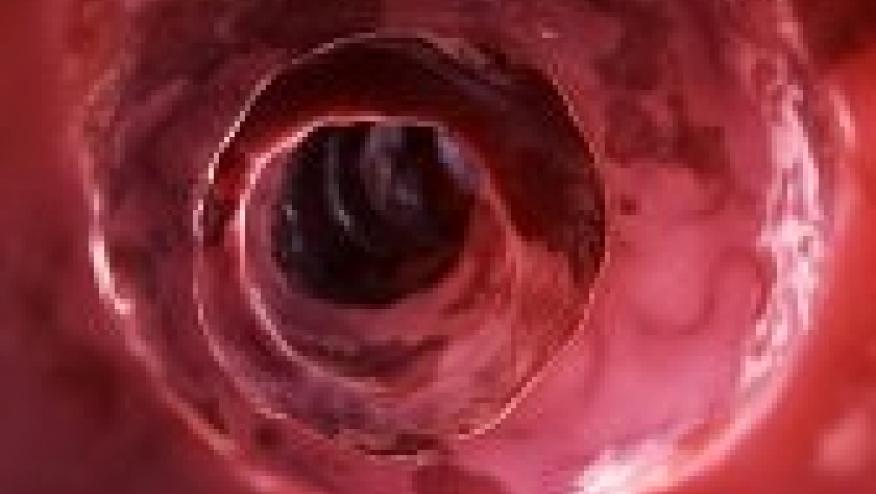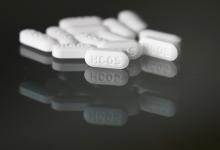Low IBD Risk with Secukinumab Save

The interleukin-23 (IL-23)/IL-17 axis plays an important role in inflammation and infection. Some of these chronic immune-mediated inflammatory disorders include PsO, PsA, AS, and IBD. Patients with PsO, PsA, and AS have up to a four-fold risk of developing IBD versus the general population. One study also supported the role for gut inflammation in spondyloarthropathy. "Initial chronic gut inflammation implied a high risk of evolution to ankylosing spondylitis. Evolution to [IBD] was observed in 7% of patients," according to authors of that study.
IL-17A is a glycoprotein with roles bridging innate and adaptive immunity. T-helper 17 (Th17) cells produce IL-17 that act on IL17 receptor-bearing tissue cells, such as keratinocytes, synoviocytes, fibroblasts, and epithelial cells. Dysregulation of Th17 cells has been implicated in many autoimmune disorders, including PsO. Secukinumab is a fully human monoclonal antibody that inhibits IL17A, and has been shown to be effective against PsO, PsA, and AS, as well as demonstrates rapid onset of action. Other biologics such as the anti-IL17A antibody, ixekizumab (Taltz), and the IL17A receptor inhibitor, brodalumab (Siliq), have also demonstrated effectiveness against autoimmune disorders such as PsO, PsA, and AS.
Results from other studies, including case reports of IBD detected in patients treated with IL-17 blockade for another autoimmune disorder, spurred the current investigation. "Inhibition of IL-17A may have dual effects, reducing inflammation but also potentially impairing residual function of an already damaged [intestinal] epithelial barrier," the researchers wrote.
To examine the incidence and pattern of IBD among patients receiving secukinumab, Stefan Schreiber, MD, PhD, of the University Hospital Schleswig Holstein in Kiel, Germany, and colleagues, pooled data from 21 randomized trials that included a total of 7,355 patients with cumulative exposure of 16 226.9 patient-years. Data were included for up to 5 years for PsO and PsA and up to 4 years in AS.
Interestingly, randomized patients received a higher secukinumab dose (10 mg/kg) than that approved for PsO and PsA (300 mg). About two-thirds and nearly half of the respective PsO/AS and PsA cohorts were male (mean age range 21-49). Baseline characteristics also included independent risk factors for autoimmune and other disorders, or a history of CD/UC/IBDU:
- Prior exposure to tumor necrosis factor (TNF) antagonists/other biologic therapies for primary disease with inadequate response: 31.5% of patients with PsA, 28.6% of patients with AS, 15.1% of patients with PsO
- Current smokers: 19% for PsA, 30% for AS, 30.6% for PsO
- 8 patients with a history of CD/UC/IBDU in PsA cohort (n=1,380)
- 25 patients with a history of CD/UC/IBDU in AS cohort (n=794)
- 15 patients with a history of CD/UC/IBDU in PsO cohort (n=5,181)
IBD events occurring in patients with a stated history of the disease at baseline were referred to as exacerbations. By definition, new-onset IBD cases did not have a prior IBD history at baseline.
Of the 41 (0.56%) observed cases of active IBD reported, 30 (0.41%) were new-onset cases. Additionally, of the 48 (0.65%) patients with a history of IBD at baseline, 11 (0.15%) patients had an exacerbation during study treatment, the authors wrote.
Exposure adjusted incidence rates (EAIRs) per 100 patient-year exposures for CD, UC, and IBDU among 5,181 patients with PsO were 0.13, 0.05, and 0.01, respectively. Corresponding values among 1,380 patients with PsA were 0.08, 0.08, and 0.05 respectively. Among 794 patients with AS, the EAIRs were 0.2, 0.4, and 0.1, respectively.
The cumulative reporting rate of IBD remained stable at approximately 0.20 reported events per 100 patient-years, based on post-marketing safety surveillance (cumulative exposure of >96 000 patient-years).
Schreiber and colleagues pointed out conclusions from this study were limited by study design, statistical methods, imbalance in baseline characteristics, and small sample size. IBD events were also not adjudicated in the current analysis.
Source Reference: Annals of Rheumatic Diseases, Jan. 23, 2019; DOI:10.1136/ annrheumdis-2018-214273
IBD events were uncommon with secukinumab treatment and the observed EAIRs of IBD did not increase over time among 7,355 treated patients (representing pooled data across 21 trials for PsO, PsA, and AS). Cumulative exposure with secukinumab (equalling 16 2260.9 patient-years), spanning up to 5 years of treatment for PsO and PsA and up to 4 years in AS.
Results were consistent with long-term secukinumab data, which demonstrated that the safety profile of secukinumab remains favourable through 5 years of PsO treatment with no increases in yearly adverse event rates, the authors noted. Post-marketing surveillance data from the secukinumab PSUR showed that the overall reporting rates for IBD, including CD and UC, were infrequent and stable (0.2 reported events per 100 patient-years).
About one-third of all patients with PsA and AS were previously exposed (with inadequate response) to TNF antagonists and less patients with PsO were also exposed to biologics (15.1%). Potential roles of current smoking and prior exposure to TNF antagonist therapies in contributing to IBD in secukinumab-treated patients are open to speculation, but ultimately not clear at this time.
Background IRs (per 100 patient-years) of CD and UC among patients with PsO, PsA, and AS were 0.3, 0.1, and 0.7, respectively. EAIR for IBD following exposure to any secukinumab dose ranged from <0.1 to 0.4 per 100 patient-years -- values that fell within the corresponding background range. Future genetic/genomic analyses may shed light on why the observed EAIR for CD was slightly higher for patients with AS (0.4) versus patients with PsO (0.1) and PsA (0.1).
Use of another IL-17A blocker, ixekizumab, has also been linked to IBD (UC and CD cases <1%). Treatment with brodalumab resulted in a disproportionate number of cases of worsening CD in patients with active CD and no evidence of meaningful efficacy, according to the authors of a separate study. In the latter case, brodalumab blocks the IL-17 receptor and may therefore have a broader impact on bowel inflammation compared with secukinumab and ixekizumab, which target the cytokine, IL-17A.
It is worth noting that there is not the same risk of overlap for rheumatoid arthritis (RA) and CD, as has been described for developing CD as a comorbidity of PsO, PsA, and AS. Additional phase III studies undertaken in patients with RA (n=1,430) and phase II trials undertaken in patients with uveitis (n=274) showed no reported cases of IBD among secukinumab-treated patients.
Only 48 of the 7,355 patients (0.65%) had a history of IBDU/CD/UC. This baseline rate is lower than previously reported for PsO (0.2%-1.6%), PsA (3.8%), and AS (6.6%-8.5%). Schreiber and colleagues attributed this difference to exclusion of patients with active ongoing IBD in the AS studies or patients with active ongoing inflammatory diseases other than PsO/PsA that might confound the evaluation of therapy in the PsO and PsA studies, respectively.
Finally, the authors proposed long-term comparative registry data to further examine the role of IL-17 inhibition on the incidence of IBD.










If you are a health practitioner, you may Login/Register to comment.
Due to the nature of these comment forums, only health practitioners are allowed to comment at this time.